 |
 |
 |
 |
 |
 |
| |
 |
|
 |
 |
 |
  |
  |
 |
 |
 |
 |
|
 |
|
 |
 |
 |
BIOGRAPHICAL NOTES |
 |
|  |
|
 |
 |
 |
| |
 |
Ettore Sottsass was born in Innsbruck, Austria, in 1917. He received his degree in architecture from the Turin Polytechnic in 1939. In 1947 he opened his own architecture and design office in Milan. Parallel to his professional work, he held solo shows of his paintings in Italy and abroad, participated in group art exhibitions and showed at several editions of the International Exhibition of Triennale Milano.
His collaboration with Olivetti began in 1958 and lasted for over thirty years, during which he received three Compasso d’Oro design awards. Among the items he designed for Olivetti are: Elea, the first Italian electronic calculator, in 1959; Tekne 3, Praxis 48, the red portable typewriter Valentine and Sistema 45. All throughout the ‘60s and early ‘70s, Sottsass’s work explored the themes that would stand central to his designs in the years to come: it was during this period that he laid the foundations for what would later be called Nuovo Design Italiano. The Ceramiche delle Tenebre are made in 1963 and the 100 plates Offerte a Shiva in 1964. Of the same year are the first pieces of furniture in wood/ceramics for Poltronova. The Superbox are designed in 1965 and 1966 and so are the large ceramic pieces Menhir, Ziggurat, Stupas, Hydrants and Gas Pumps, shown in Milan at Galleria Sperone in 1967. The show at Centro Fly Casa, Milan, opened in 1966, while the exhibition Paesaggio per un Pianeta Fresco opened in Stockholm in 1969. Finally the ceramics Tantra, Fumo and Yantra belong to the years 1968- 70 and the Mobili Grigi for Poltronova to 1970. In 1970, after a tour of conferences in different British universities, Sottsass received an honorary degree from the Royal College of Art in London.
Always in the second half of the ‘60s, Sottsass starts Pianeta Fresco, magazine co-edited with Allen Ginsberg and Fernanda Pivano and he is involved in the first debates on Radical Architecture, followed, at the beginning of the ‘70s, by several conceptual counter-design works. Also are to be mentioned: his designs for the exhibition Italy: The New Domestic Landscape (MoMA,1972); the silkscreen series Il Pianeta come Festival, 1972; the tables and stools for BBB and Tappeto Volante for Bedding Brevetti, 1974.
All along these years, Sottsass never stops writing and publishing for Domus, Casabella, other magazines or books.
In 1978,1979 and 1980, he participated in the exhibitions of Alchymia group.
In 1980 he founded Sottsass Associati Studio and Memphis.
In 1981 the first Memphis exhibition opens in Milan (shows will follow until 1987). Memphis, gathering internationally known architects and desingers, quickly became the symbol of Nuovo Design and point of reference for all contemporary avant-garde directions.
In 1988, with Barbara Radice, Sottsass founded the magazine Terrazzo, in which the themes of Nuovo Design Italiano, explored by Memphis, were developed and extended to architecture and contemporary culture.
Starting from 1985, Sottsass began focusing again on architecture.
Built designs: Wolf House (Colorado1987-89); Bischofberger House (Zurich 1991- 96); Olabuenaga House (Maui, Hawaii 1989-97); Nanon House (Lanaken, 1995-98) and Mourmans House (Lanaken, 1998-01); Yuko House (Tokyo 1991-93); VanImpe House (Sint-Lievens-Houtem 1996-98); Zhaoqing Resort and Golf Club (China 1994-96); Jasmine Hill Houses (Singapore 2000).
In 1994, a large Sottsass retrospective was held at Centre Pompidou, Paris. In 2004, the Capodimonte Museum in Naples held a large exhibition of his photographic work.
In 2005 the retrospective at MART, Rovereto.
In 2006 the retrospective at LACMA, Los Angeles.
In 2007 Vorrei sapere perché (I’d like to know why) the last show, in Trieste.
His works are in the permanent collections of a wide range of museums: Centre Georges Pompidou, Paris; Musée des Arts Décoratifs, Paris; Victoria&Albert Museum, London; Stedelijk Museum, Amsterdam; MoMA, New York; Metropolitan Museum, New York; Musée des Arts Décoratifs, Montreal; Israel Museum, Jerusalem; National Museum, Stockholm.
Among the last recognitions he was awarded: 1992, the title “Officier de l'Ordre des Arts et des Lettres” of the French Republic; 1993, honorary degree from Rhode Island School of Design; 1994, iF Product Design Award, Hannover; 1996, honorary degree from the Royal College of Art, London and Design Award from Brooklyn Museum, New York; 1997, Oribe Award from the City of Gifu, Japan; 1999, honorary degree from Glasgow School of Art; 2001, honorary degrees from London Institute of Art and from the Milan Polytechnic. Always in 2001 he received the title of “Grande Ufficiale per l'Ordine al Merito” from the President of the Italian Republic. In 2003 he was made “Commandeur de l’Ordre des Arts et des Lettres” from the Minister of Culture of the French Republic. In 2005, Sottsass received the Gold Medal and First-Class Diploma for “Benemeriti della Cultura e dell’Arte” from the President of the Italian Republic. |
|
 |
 |
 |
AWARDS |
 |
|  |
|
 |
 |
 |
|
|
 |
Medaglia d'oro con Diploma di I classe
Benemeriti della Cultura e dell'Arte
Presidente della Repubblica Italiana |
|
|
|
 |
Commandeur de l’Ordre des Arts et des Lettres
Ministre de la Culture, République française |
|
|
|
 |
Grande Ufficiale per l'Ordine al Merito
Presidente della Repubblica Italiana |
|
|
|
 |
Oribe Award
City of Gifu [Japan] |
|
|
|
 |
Award Prize
Brooklyn Museum [New York] |
|
|
|
 |
IF Award Design
Industrie Forum Design [Hannover] |
|
|
|
 |
Officier de l'Ordre des Arts et des Lettres
République française |
|
 |
 |
 |
BUILDINGS |
 |
|
 |
|
 |
 |
 |
|
|
 |
|
|
  Belgium [Belgique/België]
Belgium [Belgique/België]
» Maasmechelen |
|
|
|
|
 |
|
|
  China [Zhōngguó/Zhōnghuá]
China [Zhōngguó/Zhōnghuá]
» Zhaoqing |
|
|
|
|
 |
|
|
  United States
United States
» Maui |
|
|
|
|
 |
|
|
  Switzerland [Schweiz/Suisse]
Switzerland [Schweiz/Suisse]
» Zürich |
|
|
|
|
 |
|
|
  China [Zhōngguó/Zhōnghuá]
China [Zhōngguó/Zhōnghuá]
» Zhaoqing |
|
|
|
|
 |
|
|
  Belgium [Belgique/België]
Belgium [Belgique/België]
» Sint-Lievens-Houtem |
|
|
|
|
 |
|
|
  Italy [Italia]
Italy [Italia]
» Rome [Roma] |
|
|
|
|
 |
|
|
  Italy [Italia]
Italy [Italia]
» Empoli |
|
|
|
|
 |
|
|
  Italy [Italia]
Italy [Italia]
» Ravenna |
|
|
|
|
 |
|
|
  Japan [Nihon/Nippon]
Japan [Nihon/Nippon]
» Tōkyō |
|
|
|
|
 |
|
|
  United States
United States
» Ridgway |
|
|
|
|
 |
|
|
  Italy [Italia]
Italy [Italia]
» Massa |
|
|
 |
 |
 |
 |
BIBLIOGRAPHY |
 |
|
|
 |
|
 |
 |
 |
WRITINGS
BY THE ARCHITECT |
 |
|
|
 |
| Ettore Sottsass, Scritto di notte, Adelphi, Milano 2010 |
|
|
| Ettore Sottsass jr., "Struttura colore e luce", Casabella 765, aprile/april 2008, pp. 3-5 |
|
|
| Ettore Sottsass (ed.), Architettura attenuata. 24 disegni di Ettore Sottsass, Galleria Antonia Jannone, Milano 2003 |
|
|
| Milco Carboni, Barbara Radice (ed.), Ettore Sottsass. Scritti, Neri Pozza Editore, Vicenza 2002 |
|
|
| Etttore Sottsass, Enzo Cucchi, Esercizi, Alberico Cetti Serbelloni Editore, Milano 2002 |
|
|
| Ettore Sottsass, Mobili Lunghi, Postdesign, Milano 2000 |
|
|
| Ettore Sottsass, Trattato di architettura, Atelier Lytos, Como 1999 |
|
|
| Ettore Sottsass, Lo specchio di Saffo, Postdesign, Milano 1998 |
|
|
| Ettore Sottsass, Epifanie Brevi, Atelier Lytos, Como 1998 |
|
|
| François Burkhardt, Ettore Sottsass, "Ettore Sottsass architetto/Ettore Sottsass architect", Domus 799, dicembre/december 1997 [In un altro modo/In a different way], pp. 6-16 |
|
|
| Ettore Sottsass, in AA.VV., Emilio Ambasz. Architettura e design. Per una riconciliazione con la natura, Electa, Milano 1995, pp. XXII-XXIII |
|
|
| Ettore Sottsass, Ettore Sottsass senior. Architetto, Electa, Milano 1991 |
|
|
| Ettore Sottsass, Esercizio formale. 1979, Alessi, Crusinallo 1979 |
|
|
|
 |
 |
 |
WRITINGS
ABOUT THE ARCHITECT |
 |
|
|
 |
 Alessio Bozzer, Beatrice Mascellani, Marco Minuz (ed.), Vorrei sapere perché/I wonder why. Ettore Sottsass, Electa, Milano 2007 Alessio Bozzer, Beatrice Mascellani, Marco Minuz (ed.), Vorrei sapere perché/I wonder why. Ettore Sottsass, Electa, Milano 2007 |
|
|
"Cinquant'anni fa: Sottsass e le arti applicate", Casabella 746, luglio-agosto/july-august 2006 [Case con vista], "Design" pp. 94-97
Lucia Pesapane, "Ettore Sottsass jr.. Arazzi, tappeti e tessuti 1947-57", Casabella 746, luglio-agosto/july-august 2006 [Case con vista], "Design" p. 95 (94-97) |
|
|
| Milco Carboni (ed.), Sottsass '60/'70, Editions HYX, Orléans 2006 |
|
|
Hans Ulrich Obrist, "Interview", Domus 887, dicembre/december 2005, pp. 64-67
Hans Ulrich Obrist, Intervista a/Interview with Ettore Sottsass, allegato a/published with Domus 887, dicembre/december 2005 |
|
|
| Hans Hollein, Sottsass. 700 disegni, Skira, 2005 |
|
|
 Milco Carboni (ed.), Sottsass 700 disegni, Skira, Milano 2005 Milco Carboni (ed.), Sottsass 700 disegni, Skira, Milano 2005 |
|
|
| Casabella 719, febbraio/february 2004 [Modi d'abitare], p. 79 |
|
|
| Milco Carboni (ed.), Sottsass. Fotografie, Electa, Napoli 2004 |
|
|
| Milco Carboni, Barbara Radice (ed.), Ettore Sottsass. Metafore, Skira Editore, Milano 2002 |
|
|
| Milco Carboni (ed.), Ettore Sottsass. Esercizi di Viaggio, Aragno, Torino 2001 |
|
|
| Salvatore Lacagnina, Roberto Giustini, Barbara Radice, Ettore Sottsass e Enzo Cucchi, Charta, 2001 |
|
|
| Gianni Pettena, Sottsass e Sottsass. Itinerari di architettura, Testo & Immagine, Torino 2001 |
|
|
| Milco Carboni (ed.), Ettore Sottsass e Associati, Rizzoli, Milano 1999 |
|
|
| Gianni Pettena (ed.), Sottsass. L'arte del progetto, Maschietto & Musolino, Siena 1999 |
|
|
 Marino Barovier, Bruno Bischofberger, Milco Carboni, Sottsass. Glass Works, Arnoldsche Verlagsanstalt, 1998 Marino Barovier, Bruno Bischofberger, Milco Carboni, Sottsass. Glass Works, Arnoldsche Verlagsanstalt, 1998 |
|
|
| François Burkhardt, Ettore Sottsass, "Ettore Sottsass architetto/Ettore Sottsass architect", Domus 799, dicembre/december 1997 [In un altro modo/In a different way], pp. 6-16 |
|
|
| François Burkhardt, Ettore Sottsass, "Ettore Sottsass architetto/Ettore Sottsass architect", Domus 799, dicembre/december 1997 [In un altro modo/In a different way], pp. 6-16 |
|
|
| "Happy birthday, Ettore (14 IX 1917). Ettore Sottsass, 80 anni", Casabella 647, luglio-agosto/july-august 1997, "News" pp. 76-77 |
|
|
| Fulvio Ferrari, Ettore Sottsass. Tutta la ceramica, Allemandi, Torino 1996 |
|
|
| Barbara Radice (ed.), Ettore Sottsass, Electa, Milano 1993 |
|
|
| Guia Sambonet, Ettore Sottsass. Mobili e arredamenti, Mondadori, Milano 1985 |
|
|
| Barbara Radice, Memphis, Electa, Milano 1984 |
|
|
| Barbara Radice, Memphis, Electa, Milano 1984 |
|
 |
 |
 |
 |
THE ARCHITECT IN CINEMA |
 |
|
|
 |
|
 |
 |
 |
| Title |
 |
|
 |
|
| Directed by |
 |
|
 |
|
| Nationality |
 |
|
 |
|
| Year of production |
 |
|
 |
|
| Cast |
 |
|
 |
|
| Architect's role |
 |
|
 |
|
 |
 |
 |
 |
 |
 |
 |
INTERVIEWS |
 |
|
|
 |
|
 |
 |
 |
|
|
 |
| Stefano Boeri, "Sono un disegnatore / I am a draftsman", Abitare 479, febbraio/february 2008, pp. 7-13 |
|
 |
 |
 |
 |
EXHIBITIONS |
 |
|
|
 |
|
 |
 |
 |
|
|
 |
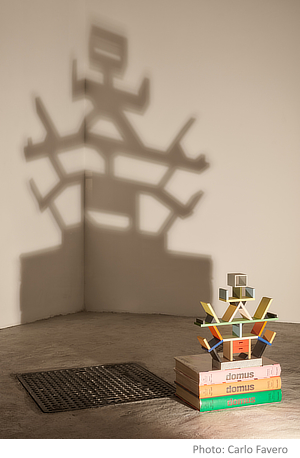 Carlton, 1981. Ettore Sottsass Carlton, 1981. Ettore Sottsass, Bologna (Italy), Garage Bentivoglio, 2 / 25 may 2024
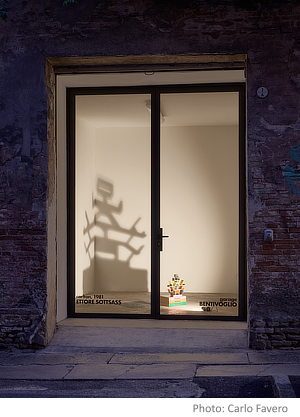 Dal 2 al 25 maggio la vetrina d’arte su strada di garage BENTIVOGLIO ospita un altro pezzo di design della collezione permanente del Palazzo: la miniatura della celebre libreria Carlton di Ettore Sottsass.
La Carlton venne presentata al Salone del Mobile di Milano del 1981 dal mitico Gruppo Memphis, collettivo di design e architettura fondato da Sottsass insieme a Michele De Lucchi, Martine Bedin, Aldo Cibic, Matteo Thun e Marco Zanini. La sua forma antropomorfa non passò inosservata, ottenendo un immediato successo ma anche attirando critiche proprio per la forza dirompente del progetto e delle sue ambizioni.
La combinazione di legno e laminato plastico, poggiante su una base decorata con laminato "Bacterio" – l’inconfondibile pattern disegnato dallo stesso Sottsass, così chiamato proprio per l’assonanza visiva tra questa superficie e i batteri visti al microscopio – ha reso la Carlton un esempio distintivo di utilizzo dei materiali moderni nel campo del design. Il laminato plastico, in particolare, aveva un significato simbolico per Sottsass, che voleva in questo modo dimostrare la possibilità di creare oggetti di design raffinati anche con materiali di consumo.
Per Sottsass la Carlton dimostrava che un oggetto di design non deve essere necessariamente serio e complesso ma poteva attingere a forme giocose, colori sgargianti, essere realizzato con materiali economici ma contestualmente affermare la sua componente autoriale e stilistica.
«La luce artificiale con la sua pervasiva diffusione nelle abitazioni rappresenta forse uno dei cambiamenti sociali più dirompenti. L’arte è invece il campo in cui le sperimentazioni tecnologiche hanno influito maggiormente sul nostro sguardo, consegnandoci statue e quadri illuminati in modo perfetto e omogeneo. Opere che per secoli avevano conosciuto l’ombra finiscono così per trovarsi all’interno delle bianche sale museali, senza più la possibilità di mutare insieme al percorso del sole. Le stanze di Palazzo Bentivoglio, spesso illuminate durante la giornata dalla sola luce che entra dalle finestre sul giardino, permettono ancora di guardare opere e arredi immersi nella penombra, di far disegnare sui muri il vago contorno delle sagome proiettate. La Carlton di Ettore Sottsass è uno degli oggetti di design più rappresentativi del XX secolo e, come tutti i mobili di Memphis, ha la caratteristica di essere egoica, di convogliare verso di sé tutti gli sguardi e non volere altro accanto, “come i monumenti nelle piazze”», racconta Davide Trabucco rispetto alla scelta di questo pezzo e al perché ha voluto portarlo in questo diverso contesto.
La libreria si staglia sul muro con la sua silhouette totemica e attesta la prevalenza della forma sulla funzione, aprendo la strada a innumerevoli librerie che hanno fatto del dato estetico la componente fondamentale, come la Bookworm (1994) di Ron Arad per Kartell.
«Così – conclude Trabucco – grazie a un semplice gioco di luci, una miniatura da collezione della Carlton si proietta sul muro a dimensione umana, portandoci a fissare l’ombra, a farcela sembrare per un attimo reale, come succedeva ai prigionieri nella mitica caverna di Platone». |
|
|
Ettore Sottsass. Design Metaphors, Milano [Milan] (Italy), Triennale Milano, 29 september 2023 / 15 september 2024
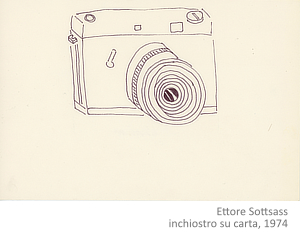 Triennale Milano is presenting the exhibition Ettore Sottsass. Design Metaphors. After Struttura e colore, Il calcolo and La Parola, the fourth project in the exhibition cycle dedicated to the great architect and designer focuses on the relationship between Ettore Sottsass and photography. Triennale Milano is presenting the exhibition Ettore Sottsass. Design Metaphors. After Struttura e colore, Il calcolo and La Parola, the fourth project in the exhibition cycle dedicated to the great architect and designer focuses on the relationship between Ettore Sottsass and photography.
As with the previous three exhibitions, Metafore is being staged inside the Sala Sottsass, which has been home since January 2021 to the permanent installation Casa Lana, a faithful reconstruction for Triennale of the interior of a private residence, designed by Sottsass in Milan in around the mid 1960s, and open to the public thanks to a donation from Barbara Radice Sottsass.
Ettore Sottsass. Design Metaphors brings together a series of photographs taken by Ettore Sottsass between 1972 and 1978 and grouped under the title “Metafore” (Metaphors); the f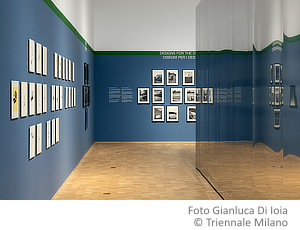 irst three groups of photographs – Disegni per i destini dell’uomo (Designs for the destinies of man), Disegni per i diritti dell’uomo (Designs for the rights of man) and Disegni per le necessità degli animali (Designs for the necesssities of animals) – were exhibited in 1976 in Man Transforms, the collective exhibition for the opening of the Cooper Hewitt museum in New York, curated by Hans Hollein with Liza Taylor. The series of photos titled Fidanzati (Fiancées) and Decorazioni (Decorations) were taken after 1976 and after the exhibition at Cooper Hewitt, during Sottsass's travels through America, Greece, the Middle East and Italy. A series of works produced during the same period is also on display at the Triennale. irst three groups of photographs – Disegni per i destini dell’uomo (Designs for the destinies of man), Disegni per i diritti dell’uomo (Designs for the rights of man) and Disegni per le necessità degli animali (Designs for the necesssities of animals) – were exhibited in 1976 in Man Transforms, the collective exhibition for the opening of the Cooper Hewitt museum in New York, curated by Hans Hollein with Liza Taylor. The series of photos titled Fidanzati (Fiancées) and Decorazioni (Decorations) were taken after 1976 and after the exhibition at Cooper Hewitt, during Sottsass's travels through America, Greece, the Middle East and Italy. A series of works produced during the same period is also on display at the Triennale.
Marco Sammicheli, Director of the Triennale Museum of Italian Design, affirms: “The use of photography alongside design reveals another of Ettore Sottsass's modes of expression, which, through the use of symbols, experiences and overlapping languages, succeed in taking the observers to places where they can understand, discover, imagine and ask themselves new questions.”
The years between 1972 and 1976 came towards the end of the Radical period of architecture; for Sottsass this was a period of great critical reflection, in which he had almost stopped designing, and instead, thought, drew, wrote and divided his time between the Milan studio and his wanderings around different parts of Spain, including Barcelona, Madrid, Almeria and Granada, but above all the rocky desert areas to the south-east of the Ebro river and the wild valleys of the Pyrenees. During his travels he constructed and photographed: initially, he only made small interventions on the landscape, creating temporary structures with materials such as twine, small pieces of wood, poles, ribbons, cardboard boxes, leaves, branches, stones, and strips of fabric. Then bit by bit the landscape made room for people to come in, with their questions.
The Costruzioni series, completed during the same years as his travels, are also included in the exhibition; these consist of studies in the language of architecture, reflections on the environment, notes on anthropology and analyses of the meaning of design which, while often starting from the study of a real object, can lead the observer onto broader meditations that often lie outside the mere act of designing itself, entering into worlds of symbolism and reflection.
Stefano Boeri
President Triennale Milano
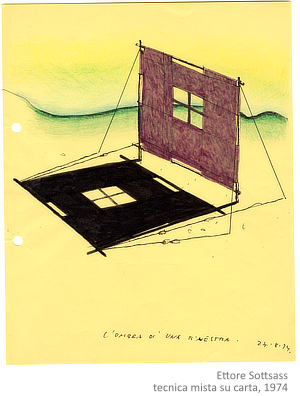 Ettore Sottsass was a great romantic hero. Ettore Sottsass was a great romantic hero.
What set Ettore apart from the ranks of artists and intellectuals who created the conditions of contemporary thought and criticism is a mysterious balance between depth and lightness. His thought, writings, designs, and photographs often succeed in awakening that impenetrable feeling of ‘being in the world’—the ultimate meaning of our lives, today, on this planet—which we usually bury beneath a thick layer of emotions, memories, and sensations triggered by everyday life.
The truth is that the ideograms, the words ‘written at night’, the ‘photos through the window’, and also his wooden furniture, ceramics with an ancestral profile, and limpid glass, nearly always raise questions about the meaning of things and life that without any effort, complication or rational intervention unexpectedly presents itself. Thus, he gives us a moment’s rest from quick thinking, a break to perceive the depth of doubt and emptiness, and also the vital intention guiding our eye at that moment.
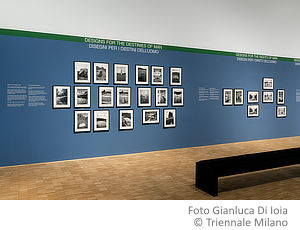 The depth that often springs from Sottsass’ works is like the parenthesis of a temporal abyss—something that perhaps only one other designer, namely Enzo Mari (not coincidentally Ettore’s accomplice in an implicit and intense exchange of feelings and respect), was able to open. The depth that often springs from Sottsass’ works is like the parenthesis of a temporal abyss—something that perhaps only one other designer, namely Enzo Mari (not coincidentally Ettore’s accomplice in an implicit and intense exchange of feelings and respect), was able to open.
Such parentheses of distilled depth can only be discerned today by studying the works of the few great heroes of the last century European avant-gardes: Nietzsche in philosophy, Mahler in music, Proust in literature, Geddes in urban planning, Borges in fiction...
But Ettore Sottsass also possessed an extraordinary mental agility.
His work functioned through bizarre associations, unpredictable correspon- dences, and epiphanic metaphors, shifting between distant fields of human existence and experience.
He was able to link a pebble in the desert to a part of human history, an anony- mous piece of furniture to a landscape, a political icon to a personal memory, and the portrait of a friend to cold rationality.
Yet the pleasure he took in discovering paradoxes and metaphors, the skilfullness of even his boldest and most risky connections, was almost never limited to the surface of things and ideas. On the contrary, it was often his metaphors and abstruse coincidences that opened the door to his profound thinking.
To the extent that the explanation of his mysterious balance between the surface and abyss of our experience can perhaps be found in his writings, designed, and drawings—in other words in the physicality, gravity, and duration he gave to his deft associations between objects, symbols, words, and faces. As evidence of another reality, as partial views of a merely glimpsed horizon, Ettore Sottsass’ works—whatever the technique or material—are first and foremost ironic and at times actually joyous devices which, combined with a cultured aesthetic equilibrium, raise a profound and unavoidable question concerning our history and our life. I had occasion to visit and interview Ettore in the small apartment he shared with Barbara in downtown Milan, a few days before he died. He became emotional when talking about migrating birds and the currents that enter the Mediterranean. He told me about the time he flew over the volcanoes of the Aeolian Islands and of his being aware of finding himself in the presence of living beings, which had a memory and feelings. Perhaps he was getting ready to enter a new dimension, the very one he had sought to fathom all his life.
DESIGN METAPHORS
by Barbara Radice
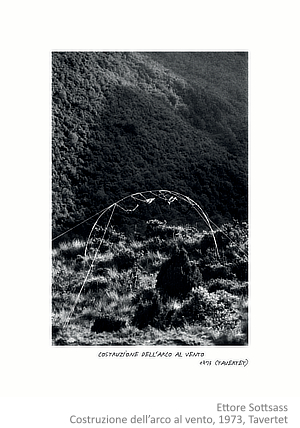 The Metaphors photographs were taken between 1972 and 1978. The first three groups of photographs, Designs for the Destinies of Man, Designs for the Rights of Man and Designs for the Necessities of Animals, date from the years between 1972 and 1976. That is, they were created towards the end of the Architettura Radicale movement. The dates are significant because, after the most turbulent protests, the first signs of reconstruction were beginning to be perceived. The Movimento Radicale Italiano, which grew up parallel to Arte Povera and Arte Concettuale and around similar themes, had been a time of important critical re- flection. Sottsass spoke of it as “a period of emptiness, of introverted meditation, of purification and the removal of what were the laws, customs and vocabulary of rationalist culture”. The topics dis-cussed were vast, involving the rethinking and re-founding of the mechanisms of design, of the role and responsibility of the architect in relation to society and public and private clients.
In those years, Sottsass had almost stopped designing. He thought, drew, wrote, he “wanted to escape”. “I felt a great need to visit deserted places, mountains, to re-establish a physical relationship with the cosmos, the only real environment, precisely because it is neither measurable, nor predictable, nor controllable, nor knowable... it seemed to me that if one wanted to recover anything, it was necessary to begin to recover microscopic gestures, elementary actions, the sense of one’s position...”.
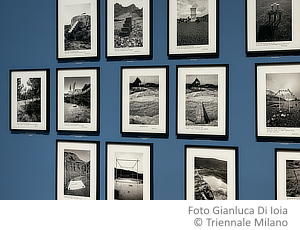 In 1970 Sottsass met a young artist from Barcelona, Eulalia Grau, who for six years was to be his companion in a semi-nomadic life, spent between work in the Milan studio and lengthy wanderings around Spain: Barcelona, Madrid, Almeria, Granada, but above all the stony deserts southeast of the Ebro and the wild valleys of the Pyrenees. Here the first photographs came into being, later called Metaphors. In those same years Sottsass had begun work on a series of drawings which he called “constructions”. They were studies in architectural language, reflections on the environment, notes on anthropology, analyses of what might be the profound, almost primordial meaning of constructing around and within life. Sottsass was looking for the link, the place where the craft takes shape and meaning within the fabric of existence. During his Spanish travels Sottsass begins to “make constructions”. He constructed and photographed. He intervened with a few signs on the landscape, erected temporary structures, put together and held up with fragile, helpless materials. He chose string, small pieces of wood, stakes, ribbons, cardboard boxes, leaves, branches, stones, strips of fabric. For the moment, man is invisible in the landscape. He leaves little trace of himself. Then his voice begins to be heard, his questions ring out against the mountains, in the motionless deserts. In 1970 Sottsass met a young artist from Barcelona, Eulalia Grau, who for six years was to be his companion in a semi-nomadic life, spent between work in the Milan studio and lengthy wanderings around Spain: Barcelona, Madrid, Almeria, Granada, but above all the stony deserts southeast of the Ebro and the wild valleys of the Pyrenees. Here the first photographs came into being, later called Metaphors. In those same years Sottsass had begun work on a series of drawings which he called “constructions”. They were studies in architectural language, reflections on the environment, notes on anthropology, analyses of what might be the profound, almost primordial meaning of constructing around and within life. Sottsass was looking for the link, the place where the craft takes shape and meaning within the fabric of existence. During his Spanish travels Sottsass begins to “make constructions”. He constructed and photographed. He intervened with a few signs on the landscape, erected temporary structures, put together and held up with fragile, helpless materials. He chose string, small pieces of wood, stakes, ribbons, cardboard boxes, leaves, branches, stones, strips of fabric. For the moment, man is invisible in the landscape. He leaves little trace of himself. Then his voice begins to be heard, his questions ring out against the mountains, in the motionless deserts.
An invitation in 1974 to participate in the opening exhibition of the Cooper Hewitt museum in New York, scheduled for 1976, was an opportunity to “get back to work”, to define what is happening, decide on titles, choose themes, pho- tographs. The exhibition, entitled Man Transforms, was curated by Hans Hollein with Liza Taylor, curator of the new museum. There were nine guests: Peter Bode, Richaard Buckminster Fuller, Murray Grigor, Arata Isozaki, Richard Meier, Karl Schamminger, Ettore Sottsass, and Oswald Ungers.
What relationship is there or can there be between people, thoughts, and the space where they stay? This question had tormented Sottsass for a long time.
In 1966 he wrote: “I have never understood why wars are planned or declared from marvellous white buildings, planted in the middle of green meadows...I have never understood why insane people are put in dirty, cold and decaying hospitals which would drive anyone sane mad. I’ve never understood why first-class couches have to be red like those in brothels. I’ve never understood why tearooms for old ladies have to be as pink as baby girl’s bow.
Work on Metaphors was to continue for some years beyond 1976 and after the exhibition at the Cooper Hewitt in New York, where the first three groups of photographs were exhibited. The photographs in the Fiancés and Decorations series were taken during trips to America, Greece, the Middle East and Italy. In these last two groups of photographs man reappears, more or less physically and culturally equipped, a little ridiculous and uncomfortable against the impassive screen of the world. The themes always concern architecture as a background and support for existence, commenting on it through thoughts and occasions of everyday life, with the light-ness and charm of a travel journal.
The photographs in the Decorations series are more distant, metaphysical, allusive. They mark the time of the end of the work, of the finished work. They are also the most poignant. They no longer question, they recognize impermanence, they pay homage to it. Decoration is not just a formal gesture. It can be an attitude, the sign of a predilection, a nostalgia, a ritual.
You can also decorate life with a drawing of its end. |
|
|
| Ettore Sottsass. La parola, Milano (Italy), Triennale Milano, 20 january / 17 september 2023 |
|
|
| Ettore Sottsass. Il calcolo, Milano (Italy), Triennale Milano, 15 may 2022 / 8 january 2023 |
|
|
Ettore Sottsass. Foto dal finestrino, Milano (Italy), Triennale Milano, 23 march / 22 may 2022
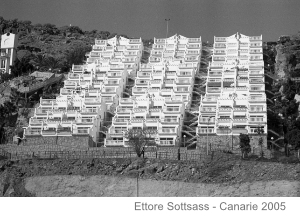 Between 23 March and 22 May 2022, Triennale Milano will be hosting the exhibition Ettore Sottsass. Foto dal finestrino (Photos from a Window), developed in collaboration with Studio Sottsass and designed by Christoph Radl. Between 23 March and 22 May 2022, Triennale Milano will be hosting the exhibition Ettore Sottsass. Foto dal finestrino (Photos from a Window), developed in collaboration with Studio Sottsass and designed by Christoph Radl.
The exhibition brings together 26 photographs – associated with as many short texts – that Ettore Sottsass took between 2004 and 2006 and published in Domus as part of Foto dal finestrino, a column created by Stefano Boeri, the magazine’s editor-in-chief at the time. These snapshots were taken by Sottsass during his travels around the world. They are accompanied by reflections about design, architecture, and urban planning, as well as by travel memories and observations about the present. In 2009 Adelphi published this project as a volume in their Biblioteca minima series.
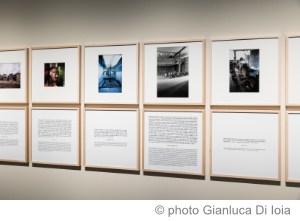 Stefano Boeri, the President of Triennale Milano, has stated: “When I became the editor-in-chief of Domus in 2004, I asked Ettore Sottsass to write an editorial for each issue of the magazine expressing his world-view. Ettore chose to start by sending us some postcards or, as he liked to call them, ‘photos from a window’: full-page pictures with a short text he had typed on his Olivetti Valentine. Ettore would pick these fragments of the world and thoughts from his vast archive of places that he and Barbara Radice had visited around the globe. The 26 snapshots of visual thoughts that we are now newly presenting at the Triennale make up a remarkable atlas of correspondences and coincidences between places, feelings experienced, and thoughts. They are like threads running between the world of inhabited places and the inner world of a great, incomparable artist.” Stefano Boeri, the President of Triennale Milano, has stated: “When I became the editor-in-chief of Domus in 2004, I asked Ettore Sottsass to write an editorial for each issue of the magazine expressing his world-view. Ettore chose to start by sending us some postcards or, as he liked to call them, ‘photos from a window’: full-page pictures with a short text he had typed on his Olivetti Valentine. Ettore would pick these fragments of the world and thoughts from his vast archive of places that he and Barbara Radice had visited around the globe. The 26 snapshots of visual thoughts that we are now newly presenting at the Triennale make up a remarkable atlas of correspondences and coincidences between places, feelings experienced, and thoughts. They are like threads running between the world of inhabited places and the inner world of a great, incomparable artist.”
India and Iran, Bali and Hong Kong, but also Milan, Catania, and Ponza: Foto dal finestrino is a collection of snapshots – both in colour and in black & white – taken with the old Leica M6 that Sottsass always used to carry with him on his travels. This series of photographs reveals Sottsass’s gaze on the reality surrounding him and his remarkable ability to combine words and images with the utmost freedom, so as to build a unique, personal narrative starting precisely from the gap between the two. Sottsass captures hidden worlds and realities that no one has ever noticed before, and which he depicts in a direct and pithy way.
As is widely known, photography accompanied Ettore Sottsass throughout his life. This photographic project offers a further immersion into his universe, which – following the 2017 monographic exhibition There is a Planet – the Triennale has also sought to celebrate and present in its lesser-known aspects. It has done so through Casa Lana – a permanent installation which since December 2021 has been open to the public, free of charge, on the first floor of the Palazzo dell’Arte – and with the series of exhibitions and other events devoted to the architect and designer that will be developed in relation to this installation. |
|
|
Ettore Sottsass. Struttura e colore, Milano (Italy), Triennale Milano, 3 december 2021 / 10 april 12 june 2022 |
|
|
| Ettore Sottsass. Oltre il design, Parma (Italy), CSAC - Centro Studi e Archivio della Comunicazione, Abbazia di Valserena, 18 november 2017 / 8 april 2018 |
|
|
| Sottsass, sperimentatore eclettico, Milano, Showroom Ceramiche Refin, 11 october / 1 december 2017 |
|
|
| There is a Planet, Milano, Triennale Design Museum, Galleria della Architettura, 15 september 2017 / 11 march 2018 |
|
|
| Ettore Sottsass. Design Radical, New York, The Met Breuer, 21 July / 8 October 2017 |
|
|
| Ettore Sottsass. Rebel and Poet, Weil-am-Rhein (Germany), Vitra Schaudepot, Temporary Space, 14 july / 24 september 2017 |
|
|
| Ettore Sottsass: il vetro, Venezia (Italy), Isola di San Giorgio Maggiore, Le Stanze del Vetro, 10 april / 30 july 2017 |
|
|
| Gianni Pettena (ed.), Pianeta Vienna e dintorni. Abraham Hollein Peintner Pettena Pichler Sottsass, Milano, Galleria Giovanni Bonelli, 30 november 2012 / 2 february 2013 |
|
|
| Ettore Sottsass et Pierre Charpin. Challenge-defying glass design, Lausanne (Switzerland), MUDAC, Musée de design et d'arts appliqués contemporains, 23 november 2011 / 7 october 2012 |
|
|
| Ettore Sottsass. Ontwerpen in email/Enamels 1958, Rotterdam, Kunsthal, 12 february / 1 may 2011 |
|
|
| Ettore Sottsass & Sottsass Associati, Luxembourg, Mudam Luxembourg - Musée d’Art Moderne Grand-Duc Jean,11 october / 1 december 2008 |
|
|
| Hommage à Ettore Sottsass, Paris, Centre Pompidou, 29 september 2008 / 31 march 2009 |
|
|
| Terrazzo 1988-1996. Ettore Sottsass, Milano, La Triennale di Milano, 25 september / 26 october 2008 |
|
|
Vorrei sapere perché, Trieste, Salone degli Incanti, 6 december 2007 / 2 march 2008
review: Gabriele Toneguzzi, "Vorrei sapere perché/Una mostra su Sottsass", Il giornale del Design, allegato a Il giornale dell'architettura 58, gennaio 2008, "Recensioni" pp. 1, 8 |
|
|
| Ettore Sottsass, Gent/Gand, Design Museum, 13 october 2007 / 15 january 2008 |
|
|
| Metafore. Ettore Sottsass, Prato, Galleria Enrico Fornello, 15 may / 21 june 2007 |
|
|
| Ettore Sottsass. A Life in Design, London, Design Museum, 29 march / 10 june 2007 |
|
|
Sottsass. Progetti 1946-2005→, Rovereto, Museo di Arte Moderna e Contemporanea di Trento e Rovereto, 26 february / 22 may 2005
review: Francesca B. Filippi, "Sottsass su Sottsass: giudicatemi!", Il giornale dell'architettura 28, aprile 2005, "Mostre" p. 36 |
|
|
| Ettore Sottsass. Architettura attenuata, Milano, Galleria Antonia Jannone, 1 / 31 october 2003 |
|
 |
 |
 |
CREDITS |
 |
|
 |
|
 |
 |
 |
| |
 |
| Biographical notes edit by Triennale Milano |
|
 |
  |
 |
|
|